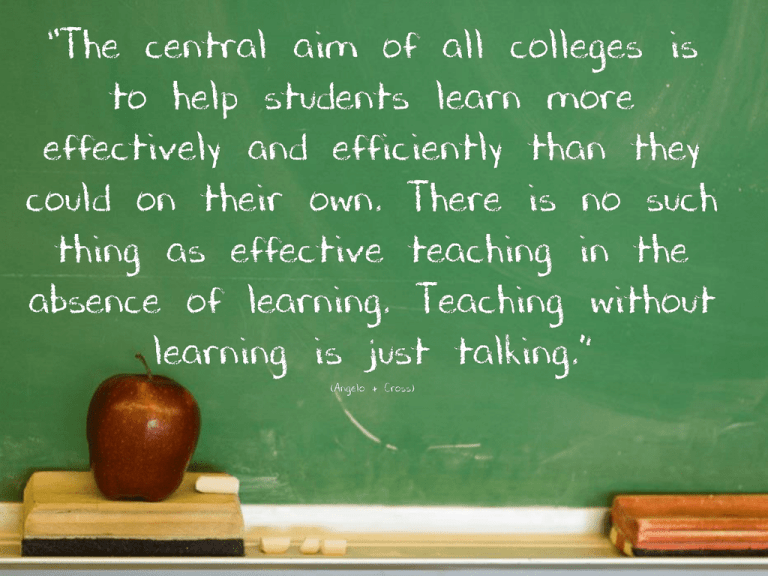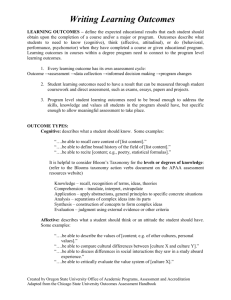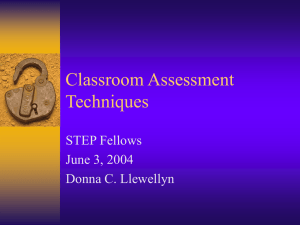1
advertisement

1 Put Your Outcomes to Work! How to Align Student Learning Outcomes with Your Assignments ECPY 761 and Assessments Katie Partin, PhD Assistant Director, Office of Institutional Effectiveness Adjunct Faculty, University of Louisville Adjunct Faculty, Bellarmine University 2016 Celebration of Teaching and Learning 2 By the end of this session, participants will be able to: • Explain Bloom’s Taxonomy • Create a student learning outcome (SLO) • Support the use of a certain assessment 3 Active Learning Active Learning requires: –Experience –Reflection –Integration –Application Dewey, 1916 4 The Learning Pyramid: The recall of different teaching strategies. That National Training Laboratories (US) Student’s recall rate Students are increasingly active, and challenged. Experience is increasingly practical and multi-sensory Listening 5% Reading 10% Audio-Visual 20% Demonstration 30% Discussion groups 50% Practice by doing 75% Teach others/immediate use of learning 90% www.geoffpetty.com or in Mujis, D. & Reynolds, D. (2201) Students Receive Information i.e. Conventional classroom-based teaching Students Apply their Learning i.e. Out There Kegan’s Bridge Metaphor Educators’ goals for what and how students should understand What students understand and how they understand It Blimling, G. S., Whitt, E. J., American College Personnel Association, & National Association of Student Personnel Administrators. (1999). Good practice in student affairs: Principles to foster student learning. San Francisco: Jossey-Bass. 3 Principles of Bridge Building • Situate learning in the students’ experiences • Validate students as knowers • Mutually construct meaning Dewey + Kegan = What students understand/how they understand it 8 (Experience Reflection Integration Application) Educator’s goals for what/how students should understand Interpretation of Kegan’s Bridge Metaphor integrated with Dewey’s (1916) ideas of active learning (as cited in Blimling, et al., 1999). The Learning Pyramid: The recall of different teaching strategies. That National Training Laboratories (US) Student’s recall rate Students are increasingly active, and challenged. Experience is increasingly practical and multi-sensory Listening 5% Reading 10% Audio-Visual 20% Demonstration 30% Discussion groups 50% Practice by doing 75% Teach others/immediate use of learning 90% www.geoffpetty.com or in Mujis, D. & Reynolds, D. (2201) Students Receive Information i.e. Conventional classroom-based teaching Students Apply their Learning i.e. Out There Student Learning Outcomes • THINK: What is a student learning outcome? • PAIR: Summarize in 1 sentence your collective understanding of a student learning outcome. • SHARE: Your sentence with the group as a whole. 11 SLOs “are defined in terms of the knowledge, skills, and abilities that students have attained as a result of their involvement in a particular set of educational experiences.” www.imt.liu.se/edu/Bologna/LO/slo.pdf 12 Outcomes • Specific statements about the end results that are expected from a department, program or service – From the perspective of the student • If well written, they are: – Meaningful – Measurable – Manageable • Tied to the mission and objectives • Focus on issues of importance • Evidence can be gathered (quantitative or qualitative) 13 14 Bloom’s Taxonomy Evaluation Synthesis Analysis Application Comprehension Knowledge 15 “Concise measurable statement that specifies what students will know, be able to do or be able to demonstrate when they have completed/participated in a program/course/project or received a service. Outcomes are usually expressed as knowledge, skills or attitudes. A measurable result of a specific, planned educational experience for students.” 16 www.uwlax.edu/learningoutcomes/edreading/LearningOutcomes.pdf Bloom’s Taxonomy Evaluation Synthesis Analysis Application Comprehension Knowledge 17 Bloom’s Taxonomy 2.0 Creating Evaluating Analyzing Applying Understanding Remembering 18 The Learning Pyramid: The recall of different teaching strategies. That National Training Laboratories (US) Student’s recall rate Students are increasingly active, and challenged. Experience is increasingly practical and multi-sensory Listening 5% Reading 10% Audio-Visual 20% Demonstration 30% Discussion groups 50% Practice by doing 75% Teach others/immediate use of learning 90% www.geoffpetty.com or in Mujis, D. & Reynolds, D. (2201) Students Receive Information i.e. Conventional classroom-based teaching Students Apply their Learning i.e. Out There Teach others/immediate use of learning Creating Practice by doing Evaluating Discussion groups Analyzing Demonstration Applying Audio-Visual 20 Reading Understanding Listening Remembering Bloom’s Taxonomy 2.0 Creating: Can the student create new product or point of view? (construct, create, design, develop, formulate) Evaluating: Can the student justify a stand of decision? (appraise, argue, defend, judge, select, support, evaluate) Analyzing: Can the student distinguish between different parts? (compare, contrast, examine, question, test) Applying: Can the student use the info in a new way? (demonstrate, employ, illustrate, interpret, write) Understanding: Can the student explain ideas/concepts? (describe, discuss, explain, identify, paraphrase) Remembering: Can the student recall or remember the information? (define, duplicate, list, memorize, recall, repeat, reproduce) 21 By the end of this session participants will be able to: • Explain Bloom’s Taxonomy • Create a student learning outcome (SLO) • Support the use of a certain SLO assessment 22 Bloom’s Taxonomy 2.0 Creating: Can the student create new product or point of view? (construct, create, design, develop, formulate) Evaluating: Can the student justify a stand of decision? (appraise, argue, defend, judge, select, support, evaluate) Analyzing: Can the student distinguish between different parts? (compare, contrast, examine, question, test) Applying: Can the student use the info in a new way? (demonstrate, employ, illustrate, interpret, write) Understanding: Can the student explain ideas/concepts? (describe, discuss, explain, identify, paraphrase) Remembering: Can the student recall or remember the information? (define, duplicate, list, memorize, recall, repeat, reproduce) 23 SLO Template As a result of participating in Upon completion of At the end of this program course unit semester lesson _______________________, students will/will compare support interpret develop create be able to __________________________ (Action verbs-Bloom’s taxonomy) ___________________________. (cognitive skill gained) 24 Specificity is Key • This course will teach students about statistics. • This course will teach students about statistical tests. • In this course, students will learn how to use statistical tests. • In this course, students will learn how to choose the most appropriate statistical test for a given problem. 25 Outcome Examples • Students will demonstrate appropriate interview skills during videotapes mock interviews. • Students will revise faulty copy for a news story. • Students will correctly classify a variety of plants. • Students will apply oral communication principles in making a speech. • Students will compute the area of a room. • Students will diagram a sentence. 26 We wrote an SLO! 27 Now what? 28 “the systematic collection of information about student learning, using the time, knowledge, expertise, and resources available, in order to inform decisions about how to improve learning.” Walvoord, 2004, p. 2 29 3 Steps to Assessment: 1. Articulate your goals for student learning 2. Gather evidence about how well students are meeting the goals 3. Use the information for improvement 30 Indirect Measures • “…ask students to reflect on their learning rather than to demonstrate it.” (Palomba & Banta, 1999) • “…signs that students are probably learning, but the evidence of exactly what they are learning is less clear and less convincing.” (Suskie, 2009) • Examples: Survey, Interviews, Course grades, Retention, Graduation 31 Direct Measures • “… require students to display their knowledge & skills…” (Palomba & Banta, 1999) • “…tangible, visible, self-explanatory evidence of exactly what students have and haven’t learned.” (Suskie, 1999) • Examples: Tests, Papers, Presentations, Projects 32 Brainstorm What type of assessment could to determine if: you use • Student apply oral communication principles in making a speech? • Students can use proper editing symbols and printers’ marks? • Student can distinguish between primary and secondary literature? 33 Formative Assessment The gathering of information about student learning—during the progression of a course or program and usually repeatedly—to improve the learning of those students. Leskes, A. (2002). Beyond confusion: An assessment glossary. AAC&U Peer Review, (4) 2/3. Classroom assessment should be: • Learner-centered • Teacher-directed • Mutually beneficial Angelo, T. A., & Cross, K. P. (1993). Classroom Assessment Techniques: A Handbook for College Teachers, Second Ed. Classroom assessment should be: • Formative • Context-specific • Ongoing • Rooted in good teaching practice Angelo, T. A., & Cross, K. P. (1993). Classroom Assessment Techniques: A Handbook for College Teachers, Second Ed. Classroom Assessment Techniques (CATs) https://ak-hdl.buzzfed.com/static/enhanced/webdr03/2013/6/25/10/enhanced-buzz-28719-1372171084-2.jpg Background Knowledge Probe • Collects specific, useful feedback on prior learning • A short, simple questionnaire used at the beginning of a course/new unit/lesson • Prepare 2 or 3 open-ended questions, a handful of short-answer questions, or 10 to 20 multiplechoice questions to probe students’ existing knowledge of that concept, subject, or topic Angelo, T. A., & Cross, K. P. (1993). Classroom Assessment Techniques: A Handbook for College Teachers, Second Ed. Minute Paper • “What was the most important thing you learned during this class?” • “What important question remains unanswered?” • Ask students to use a scrap piece of paper • Give them 1-5 minutes to respond • Spend 5-10 minutes in the next class reviewing the results with your students Angelo, T. A., & Cross, K. P. (1993). Classroom Assessment Techniques: A Handbook for College Teachers, Second Ed. Muddiest Point • Scrap piece of paper • Anonymous • “What was the muddiest point in the ____________________?” homework film lecture discussion play assignment Angelo, T. A., & Cross, K. P. (1993). Classroom Assessment Techniques: A Handbook for College Teachers, Second Ed. Problem Recognition Task •Present a few examples of common problem types (chi-square, one-way ANOVA, etc.) •Student’s must recognize/identify the particular type of problem each example represents •Choose examples of several different but related problem types that students find difficult to distinguish Angelo, T. A., & Cross, K. P. (1993). Classroom Assessment Techniques: A Handbook for College Teachers, Second Ed. Application Cards •Hand out index cards •Ask students to write down at least one possible, real-world application for what they have just learned •3-5 minutes is usually enough time Angelo, T. A., & Cross, K. P. (1993). Classroom Assessment Techniques: A Handbook for College Teachers, Second Ed. Classroom Opinion Polls •Helps faculty discover student opinions about course-related issues •Can be used to prepare to discuss a controversial issue or to assess opinions after they have studied the material •Use pre-/post-test to see if opinions have changed •Could pose a question and provide a Likerttype scale “Strong disagree to Strongly agree” Angelo, T. A., & Cross, K. P. (1993). Classroom Assessment Techniques: A Handbook for College Teachers, Second Ed. Summative Assessment The gathering of information at the conclusion of a course, program, or undergraduate career to improve learning or to meet accountability demands. When used for improvement, impacts the next cohort of students taking the course or program. Leskes, A. (2002). Beyond confusion: An assessment glossary. AAC&U Peer Review, (4) 2/3. Summative Assessment Examples • Capstone Projects • End-of-chapter/unit Tests • Final Projects • Midterm/Final Exams • Papers • Portfolios • Recital/Performances The Value of Rubrics “A rubric is an instrument based on a set of criteria for evaluating student work. …Rubrics delineate what knowledge, content, skills, and behaviors are indicative of various levels of learning or mastery. Ideally, grading rubrics are shared with students before an exam, presentation, writing project, or other assessment activity. Conscious awareness of what he or she is expected to learn helps the student organize his or her work, encourages self-reflection about what is being learned and how it is being learned, and allows opportunities for self-assessment during the learning process” (Middle States Manual, p. 42). 46 Targets: How we know we’re there! Key Components • Align to a specific measure • Expected scores; level of performance • Targets: expected number of students achieving level of performance • Express targets in percentages if student population is large enough Findings Findings Key Components • Align to a specific measure and target • Show the result of the direct/indirect assessment • Actual number of students achieving the level of performance • Express findings in percentage if student population is large enough Closing the Assessment Loop Develop or modify SLOs Develop, modify, or review course or program Determine refinements based on outcomes data 49 Design & measure SL as a result of course or program Collect, discuss, and analyze data Process of Institutional Effectiveness With permission from David Garrison, and Carol Yin, LaGrange College 51




